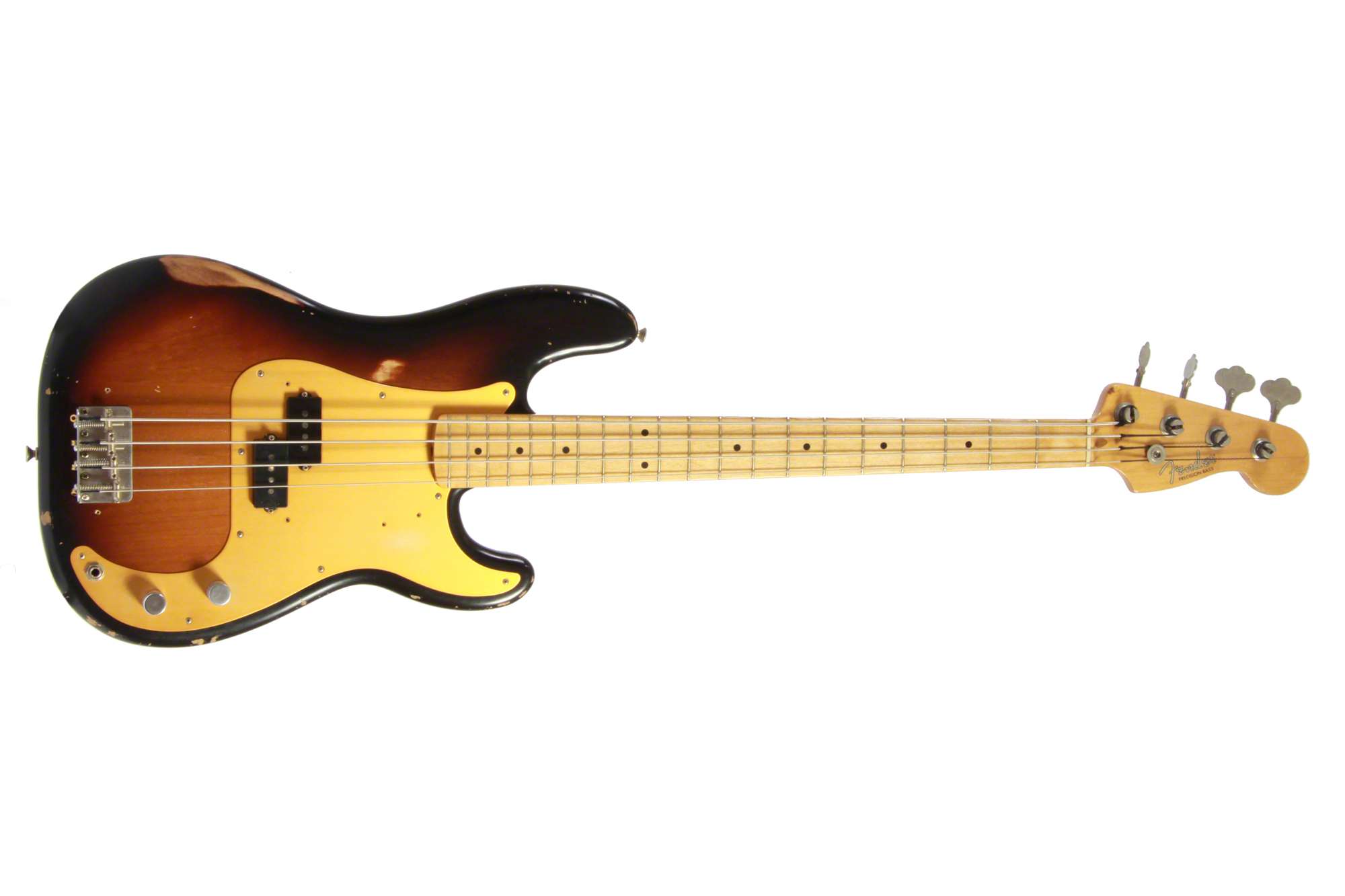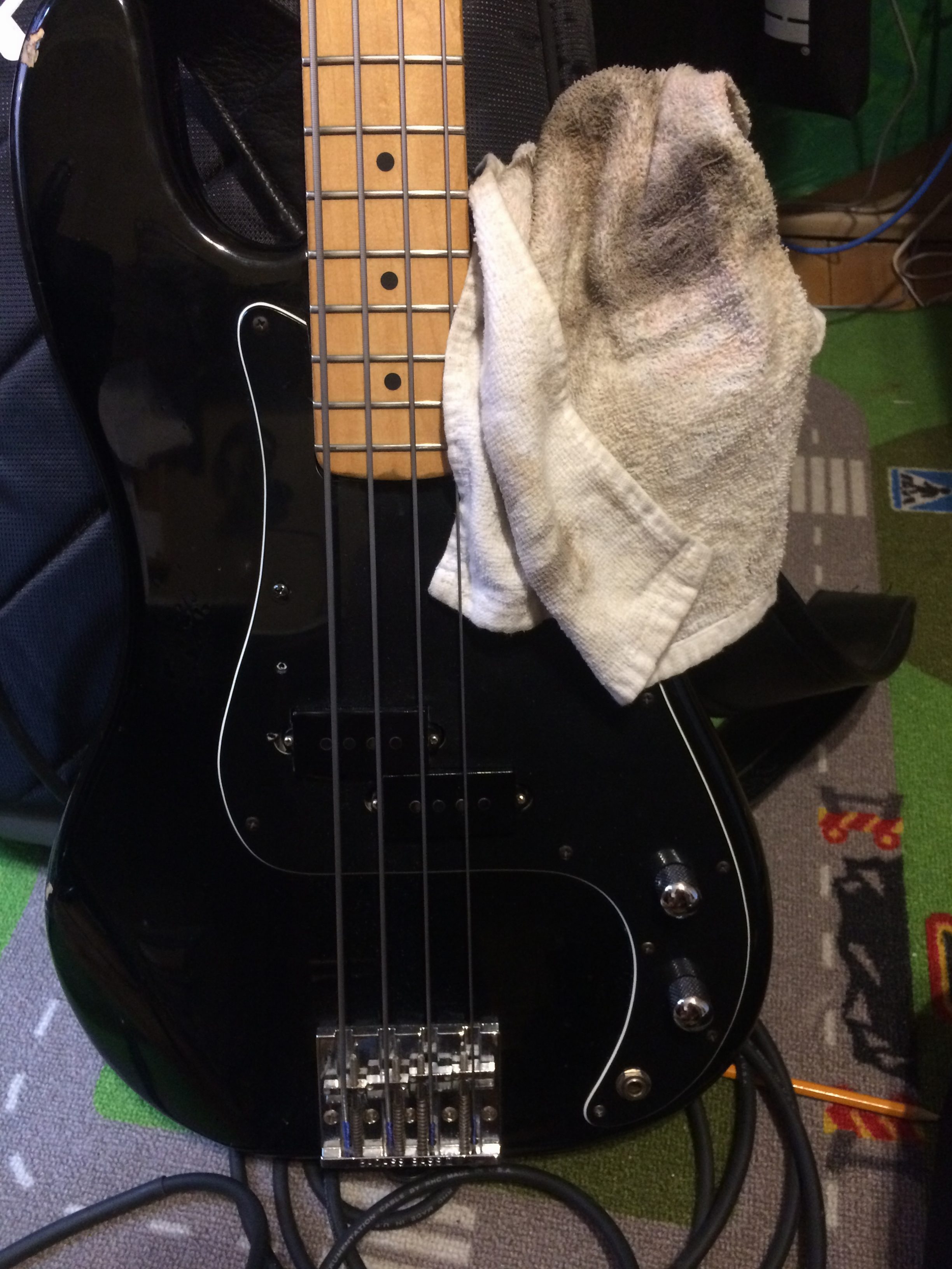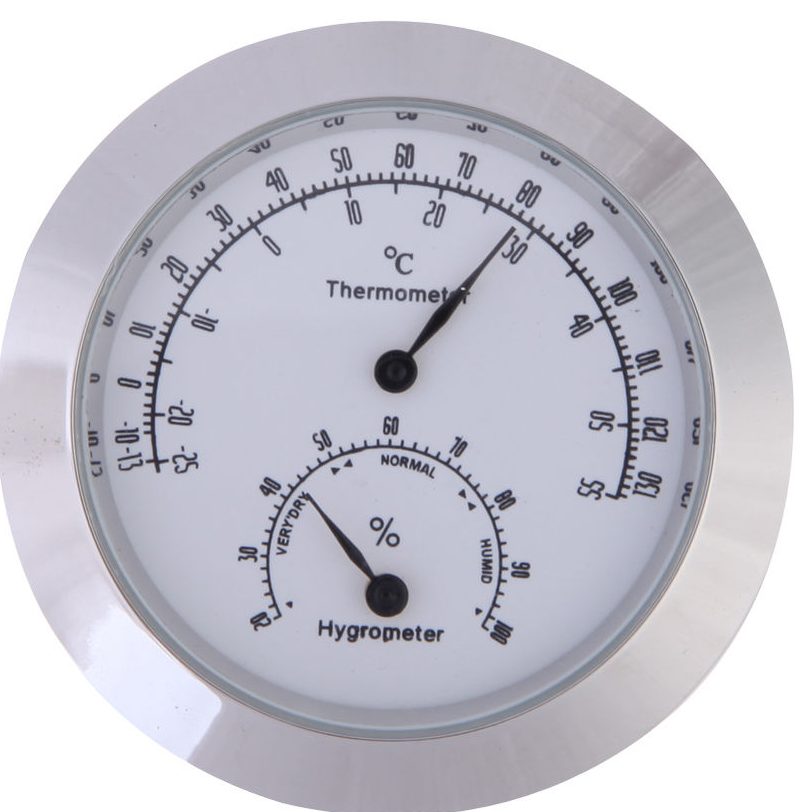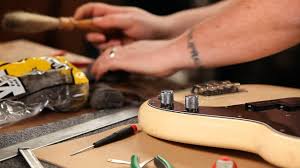
Bass guitar maintenance is essential to make sure you’re doing a great job holding down the bottom end. From cleaning strings to changing batteries, there are a good many things to consider.
Here are some bass guitar maintenance tips you’ll want to consider to help keep your instrument in top shape.
BASS GUITAR MAINTENANCE GUIDE
BASS GUITAR CLEANING
It’s so easy to neglect this area of maintenance. I know from experience, as I’m the type who is mostly concerned with playing … not cleaning afterwards. It’s important however! Your axe deserves the love!
Give A Wipe-Down
Bass guitar maintenance means cleaning the instrument after each use. Use a lint-free cloth and wipe down the fretboard, strings, and then the body of the instrument. Get in the habit of doing this after every practice or gig! A few moments of care will remove dirt, oils, and those grubby dead skin cells that would otherwise build up all over the instrument.
Wiping is only a starting point however. There are more steps to helping keep your instrument clean.
Polishing

Keep you bass guitar looking and feeling great with a regular polishing. Use a guitar polish, not a furniture polish. I found this one on Best Buy’s website, and it’s safe for all types of guitar finishes, so it should work well!
Take care to spray the polish on the rag—NOT directly on the guitar. You want to avoid getting the polish on strings, pickups and other metal parts. Be sure to NOT use the same cloth for the fingerboard as for the rest of the instrument as well. You don’t want the oils from the polish getting on the fingerboard.
Scrub It!
That old toothbrush will help a lot to clean up your bass guitar. It’s a great tool for removing dust and dirt from the hard-to-reach areas around the pickups and bridge. A quick once-over when changing strings removes dirt that’s built up against the frets.
Polishing metal
Most basses do not have as much metal hardware as guitars do. However, if you have some chrome on your bass, cleaning it can be a nice way to brighten up the look of the instrument. To clean metal components, a good metal cleaning compound is best. The compound is mildly abrasive, so be very careful to not overuse. Be very careful not to get any on the rest of the instrument either. The abrasiveness could damage the varnish on the instrument.
Electronics
You’ll need to be careful not to use any liquids near the electronics such as your pickups and volume/tone controls. I like to use compressed air to clean around these areas. It chases away the dust with little effort. Seeing that there is no fluid (only air!), there is no worry that it will damage the electronics. It’s a readily-available product, the same one you might already use at home on your computers and other electronics.
ENVIRONMENT
An often overlooked detail of good bass guitar maintenance is the instrument’s environment, because it’s difficult to mange the surroundings once the bass is out of storage and being used. However, having good storage conditions offstage and outside the rehearsal room can help prepare for when you’re working in less than adequate environments. On the whole it’s pretty simple to manage if you follow some (or all) of these details.
Extreme Temperatures
Protect the bass from prolonged exposure to extreme heat or extreme cold. It’s risky business to have your instrument in these conditions as the wood can warp, resulting in damage that is very difficult to repair, that is if it’s at all repairable. In my opinion, cold is the worst of the two as is can cause cracking on the finish of the instrumental as well. Heat can be bad too, particularly if you have a nice hollow-body “Beatle” bass. I follow two simple guidelines. The first, don’t leave the bass in the car overnight during winter. The second, don’t leave it exposed to direct sunlight for long periods during the summer.
Sudden Temperature Changes
You’ll want to avoid sudden changes in temperature as well. At the very least, the tuning will change, and in certain cases, there may be more unfortunate results. My rule of thumb: Always give an extra 5-10 minutes for the instrument to acclimatize to its new surroundings. Ideally, I’ll let it sit 5 minutes inside it’s case, then take it out for 5 minutes fully exposed, then get to work.
Humidity
This important detail can often be neglected. Too much or too little humidity can cause great fatigue or damage to any wood instrument, including your bass guitar. Where I live, the winters are very dry. To combat the dryness, I try as much as possible to keep my instruments all in one room. I use a humidifier to keep a level of humidity of around 50%. Depending on who you talk to, this may be considered too little or too much. It seems to work well for me overall.

In the summer months, it’s often very humid where I live. Depending on how intense the humidity gets, I may try to use a dehumidifier. Often, however, the air-conditioner takes care of the intense humidity in the air, creating a manageable environment for instruments.
Measuring humidity is a straightforward exercise. I use a hygrometer to do it. You don’t need an expensive unit, something like this should do the job just fine.
I also installed a humidifying device in my case. It’s a small but reassuring detail that makes a difference. I’ve tried many over the years, and I was so happy when I discovered this all-in-one product from D’Addario. It humidifies during winter and it dehumidifes as well during the summer months.
PREVENTION
Good bass guitar maintenance involves preventing problems from the get-go. Here are some notes on averting trouble through basic maintenance.
Loose Screws
Check often (every month or so) to ensure all screws are tight. Take a careful tour around the bass, be sure to check tuning heads, pick guards and strap pins. I usually have a gentle look at the pickups too, to make sure nothing is loose where it shouldn’t be. This little yet important check-up could save a frustrating search for a missing screw later on. In the case of strap pins, you may even save some damage to the guitar. There’s nothing more awkward than you and the bass flailing around onstage because a screw comes loose on the strap!
Active Pickups? CHECK. THE. BATTERY.
For those of us who use active pickups in our bass, it’s essential to keep the battery in good shape. Every bass with active pickups will have a different battery life. Some last a while and others not at all. One thing is for certain, however. If you’re using the bass a lot, you’ll need to change the battery more often. I make sure the battery is changed well before I expect it to run out of energy.
You might want to buy a professional quality battery. They actually have a bit more power in them, which allows them to last longer and have a much more stable signal overall. Because no juice … no sound!
Professional Maintenance

Nothing replaces an experienced technician when caring for your instrument. A good tech is an artisan too. They really know their stuff. From adjusting truss rods to crowning frets, aligning pickups or cleaning electronics, a good bass guitar technician can make your instrument feel like new, or even improve it!
During my visit, if any non-urgent issues are discovered, I can discuss a plan for getting them fixed. Any immediate issues can usually be dealt with on the spot during the “check-up”. I have a few instruments, and taking them all in all of the time is simply too costly. Therefore, I take care of my primary instruments more regularly, worrying about the others when my budget allows.
Other Details to Remember for Bass Guitar Maintenance
- Buy a stand. Prices vary based on your needs, but it’s always money well spent. Best Buy has a large selection to choose from.
- Be aware of what you wear! That fancy belt buckle you have might just be wearing a big hole through the back of your instrument.
- Organize your cables. Be attentive to where you’re running your cables while in the studio, and especially when onstage. Stepping on a cable at best will cause a stumble. Furthermore, it may damage the input jack on the guitar.
STRING CARE
Changing Strings
Every bassist has a different opinion on how often strings should be changed. Regardless of your take on the subject, there are a couple of technical points to think about when the strings do need to be changed. First off, do not remove all of the strings at once. Do 1-2 at at a time. This is a good idea because removing all strings at once may cause a sudden drastic change in tension in the instrument. One never knows, but the bass could react poorly to this change, causing damage.
Secondly, make sure that you wipe both the top and bottom of your strings after each session. Use an old t-shirt or a micro-fibre cloth. They seem to work best. It’s that simple!
CASES
Solid, semi-rigid, or soft?
This is a big topic, too big for today’s post. It’s really hard to say which kind of case is best. It depends a lot on your needs and preferences. Some swear by hard cases, others prefer the convenience of a lightweight gig bag. I use Mono brand cases, as they seem to offer a great balance between weight, rigidity and portability.
Guitar Maintenance and You
Use these tips to help you with your bass guitar maintenance routine. There are many things to consider! If you’re wondering where to begin, choose the simple procedures and work forward from there. If you need any equipment for your work, Best Buy has a nice selection of everything you’ll need on their Guitars & Accessories page.
Do you have any tips and techniques to share about bass guitar maintenance? Let us know, let’s help each other keep these instruments in top shape!



